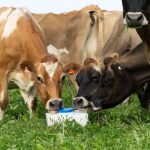
Irish dairy farmers can expect an average income from farming of €70,000 this year. That would be some 50% more than what they earned in 2023, a year when dairy incomes fell by €100,000 compared to the previous 12 months.
In 2024, the average Irish dairy farm should see a net margin in the range of €0,10 to €0,11 per litre, an increase of 40-50% on the 2023 level, the Agricultural and Food Development Authority Teagasc reports in its ‘Situation and Outlook Report’.
In the year till August 2024, milk production in Ireland is down by 5% year-on-year at 5.3 billion litres, latest figures from the Central Statistics Office in Dublin show. That decline is due to unusually low deliveries in the first months, with a decline of 22% in January and 13% in February.
Those sharp drops were due mainly to extremely unfavourable weather conditions last autumn and early this spring. The last few months show some recovery, with a decline of just 3.3% in the month of July. Moreover, dairy cow numbers in 2024 are down marginally and milk yields per cow are down on the 2023 level.
Increase in milk prices
In response to lower production figures, dairy cooperatives have increased milk prices. The largest processor, Tirlan, increased its July milk price by 1.75 cents per litre to 44.83 cents per litre at 3.8% butterfat and 3.3% protein, while Aurivo went even higher at 45.32 cents per litre or 2.5% more than for deliveries in that month.
Teagasc predicts that the average Irish milk price for 2024 is now likely to be up 7% on the average for 2023. Relative to EU competitors’ milk prices, Irish milk prices have risen to a greater extent over the last 12 months, the organisation adds.
Input costs down
Also, input costs in Ireland have dropped. Fertiliser prices are declining in 2024, but prices remain higher than they were. Lower expenditure on fertiliser – perhaps a reduction of 20% relative to 2023 – is anticipated by Teagasc. Feed prices are likely to be about 12% lower than their level in 2023.
Average total milk production costs per litre in 2024 are likely to be down slightly on the 36.7 cents per litre average recorded in 2023. However, production cost developments in 2024 could be farm specific, with local weather conditions and grass production being a factor, the research and advice authority stresses.
Milk production
At a global level in 2024, milk production volume is relatively in line with 2023 in the major dairy export regions (EU, US, NZ), the Irish organisation reports. For the EU, milk production is up by about 1% so far this year, with higher production in Poland, Italy and France, and lower figures in the Netherlands and Denmark. UK milk production in 2024 is relatively unchanged on the 2023 level.
Strong dairy production growth continued in China in 2024, which will have an adverse impact on import demand, Teagasc expects. International dairy product demand in H1 of 2024 has been strong, aided by growth in the Middle East and parts of Southeast Asia. Globally, there is a risk that higher dairy prices will adversely impact consumer demand, the Irish agricultural and food institute warns.
You can now read the most important #news on #eDairyNews #Whatsapp channels!!!
🇺🇸 eDairy News INGLÊS: https://whatsapp.com/channel/0029VaKsjzGDTkJyIN6hcP1K

























